DISCO Story
- Story 1
- Story 2
- Story 3
- Story 4
- Story 5
- Story 6
The passion for craftsmanship in the origin of our business
From grinding wheels to a future on the tip of a fountain pen
In 1937 Kure City, Hiroshima, industrial blade and wheel manufacturers were crowded around the Kure Naval Arsenal which was responsible for the construction and development of warships and weapons. Mitsuo Sekiya who had returned home from Manchuria saw this as an opportunity and founded the “Dai-ichi Seitosyo”. However, as a later manufacturer, orders from the naval arsenal were not received as planned, and Osaka, where he had focused his sales activities continued to request severe price decreases. Knowing that “We won’t survive at this rate”, he established an office in Kanda, Tokyo, and began to sell to private sector corporations on his own. It was the first turning point in the four years since the company was established.
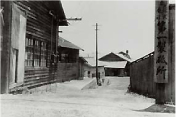
The second turning point came in 1941, the year following the expansion to Tokyo. It was the acquisition of a company which manufactured grinding wheels for grinding and polishing small parts. Taking advantage of the acquisition, focus was placed on precision grinding wheels, and the production of the resinoid abrasive wheel using a new manufacturing method was successful. This new method could produce very thin grinding wheels, which made it possible for them to be used for precision cutting.
The newly developed 1.2 millimeter thickness high precision resinoid wheel rode the housing boom of the post-war recovery by finding widespread adoption for the grinding of the edges of magnetic discs used as an part for watt-hour meters in homes. Taking advantage of DISCO’s track record, in 1956, by the request of a large scale fountain pen manufacturer, a new 0.14 millimeter ultra-thin blade was developed to cut the tips of fountain pens. DISCO obtained 100% market share in this market segment. Subsequently, the grinding wheel developed for fountain pens was thinned to 0.1 millimeters and found widening applications, including the processing of electronic parts.
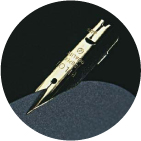
In 1967, one salesman brought about the next turning point for DISCO. He obtained information regarding how “if a blade that was half as thick as the blade used for fountain pens (70 micro meters) could be made, it would find applications in the cutting of semiconductors.” One year later, the 40 micrometer ultra-thin resinoid dicing blade (MICRON-CUT) was successfully developed, and DISCO and the semiconductor industry continued into the future full steam ahead.
Greeting the world with a new name , DISCO !
Grinding wheel and blade manufacturer, creating the semiconductor equipment industry
DISCO’s predecessor, the Dai-Ichi Seitosho CO., Ltd., developed the 40 micrometer ultra-thin dicing blade “MICRON-CUT” in 1968, which earned them a “Top 10 new products” award from the Nikkan Business Line in the following year.
The turning point which lead to expansion overseas came from an unexpected source. An American of Japanese descent saw the news and sent DISCO an invitation, “Your business is interesting, even though it is the processing of semiconductors. Your product has great promise in the USA. Would you like to form a partnership to try and sell it?”
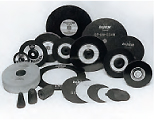
When establishing the company in America, the original Japanese name was difficult for Americans to pronounce, so the name was abbreviated like many other companies did at the time. The first letters of the English name, Dai-Ichi Seitosho CO., Ltd. were taken to create the name “DISCO”. In December 1969, DISCO Abrasive System, Inc. was incorporated in the United States, and the first expansion overseas was complete.
In the midst of our expansion, we ran into a large wall. At the time, Dai-Ichi Seitosho CO., Ltd., was a dedicated grinding wheel and blade manufacturer, and the creation of prototype equipment was done in cooperation with external companies. Once it was decided that DISCO would officially develop equipment, no equipment manufacturer would cooperate with us.
“We have a good product (wheels), but no equipment exists to take full advantage of its capabilities. But, a business opportunity is right in front of our eyes... Looks like we have to do it ourselves. Let’s make our own equipment!” And with that, a one man project was started in a garage.
With no equipment or manufacturing experience, the number of group members grew to 4, and after many experiments, the predecessor of our current dicing saws, the DAD-2H, was completed in 1975, 7 years after the development of the MICRON-CUT. The unit was displayed at SEMICON West in Silicon Valley that year.
During the trade show, the silicon wafer dicing demonstration continued with no breaks or stoppages. It became known as the “non-stop machine” and triggered a whirlwind of wonderment and praise. As a result, DISCO received over 500 business inquiries.
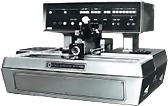
In 1977, 2 years later, the head office also changed its name to DISCO Corporation, and took a new step forward bearing the mantle of a cutting edge semiconductor equipment manufacturer.
Don't lose to the Silicon Cycle!
The light and shadows of smooth business growth
In 1975, after the success of SEMICON West, the predecessor of our current dicing saws, the DAD-2H, received praise for its ruggedness and high performance. This led to continued orders from semiconductor manufacturers all over the world. At the time, televisions and family appliances were starting to improve their functionality, and with it, the demand for semiconductors skyrocketed. DISCO’s equipment was in such popular demand, that supply could not keep up with demand. To combat the situation, DISCO established sales and service affiliates overseas.
Around that time, an unprecedented event in the semiconductor market occurred worldwide. The peak demand that was welcomed near the year of the Olympics sudden collapsed and only estimated to recover 4 years later. It was the beginning of what is now known as the Silicon Cycle. However, despite the difficult business environment, DISCO’s 1985 sales figures were ten times the figures from ten years earlier. This was possible because DISCO did not rely on its existing technology, and not only because DISCO continued to improve its existing technology to meet the needs of its customers, but also because DISCO implemented global level after service system before any of its competitors.
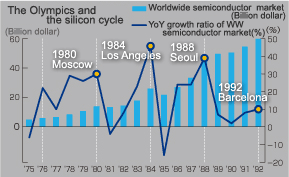
DISCO continued to broaden its business field, and in 1983, together with a European corporation, it developed a vertical oxidation and thermal diffusion furnace for a different step in the semiconductor manufacturing process. This branch was an unknown branch for DISCO which had had its growth rooted in blade and wheel technology.
Even so, at the time, DISCO which was driven by the success of its equipment business, continued to develop for this path while expanding the existing main business. However, in 1986, due in part to the burden of R&D investment, financial performance took a plunge. DISCO experienced the “valley” of the silicon cycle for the first time. Although, financial performance did recover temporarily, DISCO could not win against the wave of the Silicon Cycle. For the first time since the founding of the company, DISCO accrued a 600 million yen ordinary loss in 1992, and it was decided that DISCO would withdraw from this market
In addition, challenging new fields also brought with it unforeseen difficulties. As a result of continually dedicating limited human resources to new fields, semiconductor dicing equipment from competing companies had come to the forefront and cracks were beginning to form in DISCO’s competitiveness. The only way to drag DISCO back from the edge of the precipice was to introduce a competitive unit to the market
From a bystander’s point of view, the successful development of semiconductor equipment, the expansion into new fields, and the listing of DISCO on the stock market all showed smooth sailing, but behind the scenes, there was both light and shadow.
Shortly prior to the decision to withdraw from the new field, a project for which failure was not an option was started.
Carry out the "X project"
A miracle with the company's fate at stake
In 1991, although the company was performing well, dark shadows were on the horizon for DISCO. Chairman Hitoshi Mizorogi, the head of sales division at the time, felt a loss of the competitiveness and saw a decline in market share for dicers (precision cutting equipment). Additionally, one more person, Kazuma Sekiya, who was the nephew of the president of DISCO at the time, had already developed an image processing machine as an engineer, but he felt a sense of crisis regarding “the lack of competitiveness of DISCO’s dicers compared to those of other companies”. To propose the development of new equipment designed to suit the needs of customers, he approached Chairman Mizorogi directly.
The order was issued on January 1st, 1992. The goal of the “X project” was to develop new equipment that could be presented at SEMICON Japan 1992 at the end of the year. Kazuma Sekiya was a third year employee and was appointed the leader of a team dedicated to the development of new equipment, where the average age of the project members was 25 years old.
In that year, our company moved ahead with a restructuring plan because of a depression in the semiconductor industry. The restructuring plan included: cutting wages for management positions above administrative executive, regulation of overtime work, introducing early retirement, and canceling our new project for a horizontal diffusion furnace. In fiscal year 1992, we made a loss for the second time since the institution’s formation. In such a situation, the members of ‘Project X’ focused on the tasks ahead of them with high motivation as a united group.
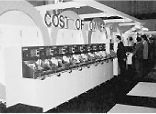

In this project, they sought an unprecedented amount of miniaturization and cost reduction. The existing semi-automatic dicer was 850 mm in width, but the DAD320 was the smallest in the industry with a width of 500 mm. Furthermore, by thoroughly rethinking what a dicer should be, the design of every part was reviewed. As a result, the number of parts was greatly reduced, while fundamental performance was improved. In addition, progress was made towards the commonization of parts, which had not received much prior attention. The project members sacrificed their weekends, fought day and night, and succeeded in bringing about a cost reduction of more than 30%.
On December 2nd, the DFD620 and DFD640 fully automatic dicing saws and ten DAD320 semi automatic dicing saws were on display at DISCO’s booth at SEMICON. The young team had succeeded in developing groundbreaking equipment in the short period of a year.
Afterwards, the annual business performance for fiscal year 1993 returned to black figures thanks to the brand-new products rolled out to the market which matched with customer needs. Subsequently, the X project did not just create a number of different products, but also greatly changed our existing way of work, including how we viewed development time and cost. This success story continues to be told in the office and became big turning point for DISCO’s growth.
The birth of DISCO Values
In addition to the good sales of the new equipment born from the X-project, DISCO’s financial performance was also buoyed by the personal computer boom, which brought stunning growth to the semiconductor and electrical part industries, and expansion continued. On the other hand, Kenichi Sekiya (current honorary chairman) strongly felt the need to create a clear, reasonable management vision and corporate culture to unify the energies of all employees.
The growth up until this point had been supported by an overwhelming “try everything” corporate culture which had been born from the equipment development endeavors in the 1970s. However, due to the increase in scale of the company from the outreach into vertical diffusion furnaces and other initiatives, many middle managers were hired externally, and the company was swamped with differing value systems.
Much time with little result was spent debating what kind of vision DISCO should have. In the end, the management began researching a management vision and a corporate culture to form the foundation of achieving that vision in collaboration with a management foundation structure specialist (Grey Institute of Management).
On December 20th, 1995, the DISCO FUTURE PROJECT-α was started with 10 executive members. They started the project by reconfirming the framework of the overall management foundation and clarifying the areas of the core values of the corporation which should be prioritized to achieve the envisioned result (this would become the core of our corporate culture). Every month, a debate would take place regarding what DISCO’s role in society should be and what DISCO’s line of business should be, which reexamined DISCO’s corporate activities from their origin. Although, initially, the debates were a clash of different ideas, through thorough discussion, a shared system of values was formed.
On December 2nd, 1997, the results of two years worth of discussions were presented to employees at the “Future Presentation”. DISCO Values, which defines what kind of corporation DISCO should be and its future direction, DISCO Vision, which sets a target for what kind of corporation DISCO would like to be by 2010, were announced.
Subsequently, as DISCO Values (DV) was made more robust, plans to increase the permeation of DV within the corporate structure and official areas began. A system to share DISCO Values was developed and implemented as a management system. Through these activities, thinking such as valuing “what is correct” over “who is correct” was made a standard and valuing what is reasonable permeated through out the company. The change in thinking strengthened the organization, and delegation of power which had previously been concentrated with the top management gradually progressed.
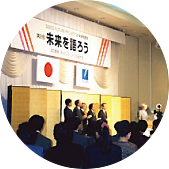
Near the time when DISCO grasped its new compass, DISCO values, and oriented itself towards its new targets, rough waves hit the global IT economy. DISCO had been desperately increasing production for several months in a row to meet the tremendous demand from semiconductor and electrical part manufacturers to expand their facilities. As a result, DISCO achieved its best ever financial results in 2000. However, the next year, the IT bubble burst. As the world sunk into economic depression, DISCO’s sales also shrunk by 59%. However, there was no uncertainty about the future. DISCO’s goal was not to make a large profit, but to qualitatively improving its ability to achieve its mission of “Bringing faraway science to comfortable living through advanced Kiru, Kezuru, Migaku technologies” as written in DISCO Values.
Towards the signpost for true growth,DISCO Vision
Personal computers and cell phones experienced explosive growth in 2000. Many semiconductor and electronic part manufacturers made daring capital investments. Accordingly, DISCO’s sales also leapt by 1.4 times compared to the previous year. However, upon entering into 2001, the IT economy rapidly lost momentum, and the overly exuberant capital investment came to an abrupt halt.
The valley of the Silicon Cycle that year was the deepest in the history of the industry, and in a sudden reversal the entire industry began the downsizing of their management, which moved the industry further towards requiring a restructuring. In the midst of this, even while trying every method to reduce operating expenses, a reduction of 60% in sales meant that DISCO accrued a loss of 1800 million yen.

However, Hitoshi Mizorogi who was handed the leadership baton from Kenichi Sekiya in June 2001 faced this unprecedented difficult business environment with a strong belief that “this is the worst it can get.” The reason for this was the DFP (DISCO Future Project), forged through thorough debates and started in 1995, clearly stated the direction that the management should aim to pursue.
The direction was “Pursue not a growth in quantity, but an improvement in quality.” In other words, the goal of the company was not to increase numbers which reflected the scope of the company like sales figures or the number of employees, but to make the figures which reflect the quality of profit, such as the gross profit, and all make all corporate activities excellent.
The management, centered on Mizorogi, believed that raising customer satisfaction (CS) and employee satisfaction (ES) which supports it as necessary for increasing the quality of management. In April 2003, the CS charter was signed and incorporated as a management system and the organization was changed so that it was possible to continuously pursue CS as an organization. In addition, with the implementation of the employee satisfaction survey in 2004, focus was placed on making a workplace worth working for.
In addition, to prevent the accumulation of inventory, factory production switched from planned production to pull production (only the number shipped is put into production.) From the income point of view, a unique management system called Will accounting was put into place. Will accounting is a concept where in addition to fixed expenses and variable expenses, when incurring expenses for the company an equivalent cost in Will for the decision will be incurred. The structure works such that when income worsens, employees will work to reduce the incurred expenses to preserve the gross profit. Furthermore, since 2004, the company has deployed many activities around the company to reduce structural costs, and each department has met its goal of reducing the previous year’s expenses by 5% for four years in a row.
Since 2003, the company has promoted the implementation of PIM (Performance innovation management). In PIM, each department sets indicators based on what they believe is the ideal form of their department. The goal is for departments to look back at short intervals and formulate method changes based on they have noticed (kizuki) to drive the evolution of the overall organization. This method has become a DISCO standard management method which has also been implemented at our overseas affiliates and, even now, is a large driving force in achieving the DISCO Vision.
It has been 70 years since 1937. From a later grinding wheel manufacturer, DISCO has survived many turning points to arrive at where it is today. Research into the possibilities of Kiru, Kezuru, Migaku technology applies not only to improving the precision of precision cutting with wheels, but also to thinning and laser technologies which will support future revolutionary semiconductor technologies. DISCO will continue to evolve and aim to improve the quality of every aspect of its corporate activities to bring greater comfortable living to people using its unique technologies.
